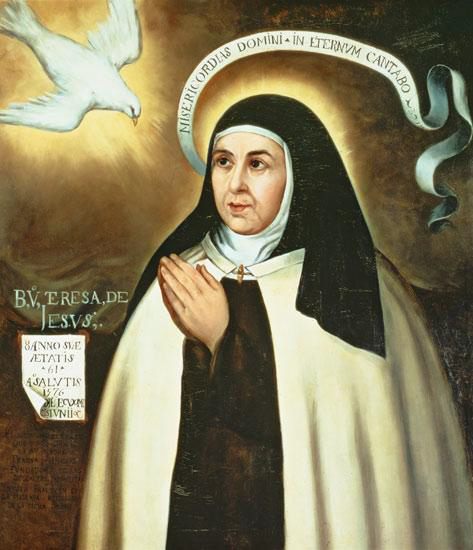There are, also two paintings, the work of brother Juan de la Miseria, whom I mentioned earlier as having joined the Reform at Pastrana. The first is a portrait of Teresa done at the request of her nuns before she left Seville in 1571. “God forgive you, Brother Juan! How ugly and bleary-eyed you have made me!” was her comment on the finished painting. The words were spoken in fun. Later generations, however, have used them as an excuse to belittle a portrait which has much to commend…..Like many done during the same period in England, it has character and honesty. The hands, the dove and the scroll, all added later, can’t be ignored. The allure of the painting is in the face framed in the white coif and black veil. There is nothing sanctimonious about it. It is pleasing rather than beautiful, serene, not ecstatic. The dark eyes under the well-defined arched brows have a humorous quizzical expression; they are eyes that see God, but they also see man, with a gentle, amused tolerance. Bernini has given us the Baroque Teresa: the visionary with rapturous gaze and flowing draperies caught up in heaven upon the clouds, the angel piercing her heart. Juan de la Miseria’s Teresa is the saint who, while convinced of the truth of her visions, is forever questioning their validity, forever seeking assurances from those more learned than herself; who can laugh at herself and be prepared for her confessor to laugh too. “Que San Pablo parar vox cosas del ciedo!” Quite a Saint Paul with her heavenly experiences! This is the Teresa who traveled up and down Spain, slept in verminous inns, humored mule drivers and archbishops—a saint too natural for the Baroque world to understand; one who in evidence of her canonization was remembered more for her kindness and gaiety than for her visions.
The second painting is of Lorenzo’s daughter. It shows the ten-year-old Tersita wearing the Carmelite habit. The face is plump and smiling. The dark, intelligent eyes are the eyes of Teresa. –‘A Journey in Spain: Saint Teresa’ Elizabeth Hamilton.


Bernini’s St Teresa

